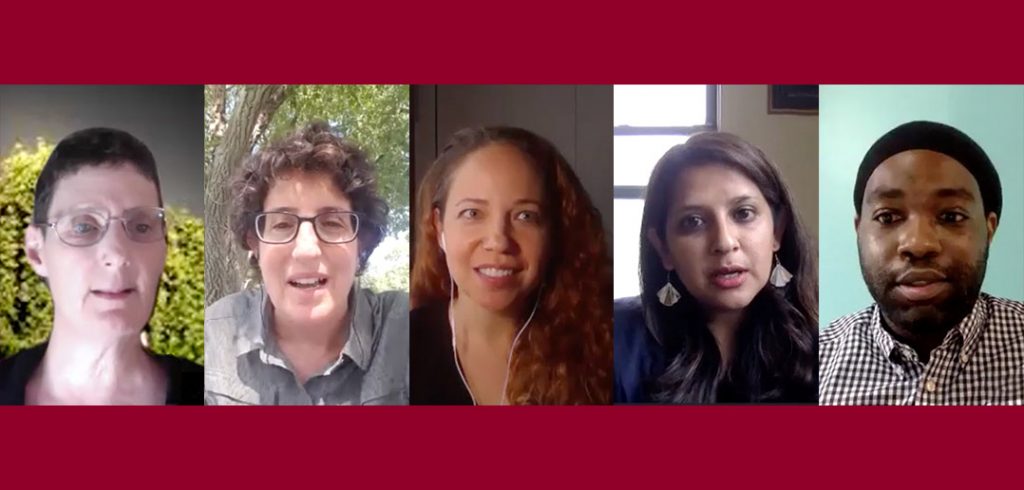But what happens when exclusion arises within those very groups?
A panel of Graduate School of Social Service professors grappled with that and other questions during a virtual event, Exclusion in Queer Spaces, that showed just how multilayered and complex it can be to create a more just and inclusive society.
Hosted by the Office of Alumni Relations, the Aug. 13 event grew out of concerns “that some members of the alumni community may have felt excluded from particular spaces, or alternatively, very included,” said Assistant Professor Sameena Azhar, Ph.D., one of five panelists who offered their views and took questions. Approximately 60 people attended, most of whom were alumni.
Layers of Exclusion
Panelists noted that exclusion can happen on many levels because queer people can have other intersecting identities—based on race, disability, or other traits and life experiences.
“Creating queer spaces [implies] this leaning towards inclusivity, but oftentimes people are still put in boxes within those boxes that they find themselves in,” said Assistant Professor Christopher Curtis, Ph.D. “And because things like privilege are so invisible, and we don’t see how we’re weaponizing that against people who check the same oppressed boxes we do, it is allowed to spread and grow and thrive.”
Another panelist, Associate Professor Laura Wernick, Ph.D., gave an example. One of her research projects, conducted at predominantly white universities in the Midwest, found that group activism helped white LGBTQ students cope with the depression brought on by discrimination.
The story was different, however, for LGBTQ students of color in these groups: Their depression grew worse. “Among students of color in these predominantly white organizations … the marginalization becomes strengthened,” Wernick said in a follow-up interview. Implicit and explicit racial bias exists within many LGBTQ organizations “culturally and politically grounded in [w]hiteness,” notes the 2016 study co-authored by Wernick and published in the Journal of Homosexuality.
The study raises interesting questions about what it means to be a queer organization and the conditions under which it becomes exclusionary, Wernick said.
One solution is having groups on campus for students with multiple identities. “Queer and trans folks of color don’t even have to be participating in it to benefit from it. Knowing it’s there is huge,” she said in the follow-up interview, noting the possibilities for collaboration among such groups on campus to foster greater understanding.
Wernick added that new faculty member Derek Tice-Brown, Ph.D., has taken the lead in forming affinity groups around race, and possibly gender and sexuality, at the Graduate School of Social Service for the coming year.
Queer Spaces and Social Constructs
The talk moved beyond groups and organizations to larger concepts of queer space. Panelist Tina Maschi, Ph.D., an associate professor, defined it as “not just a simple physical type of place, but this field of possibilities”—including genderqueer, gender fluid, and other identities—that allows for a certain amount of artistry.
“I consider myself all of the above plus more,” said Maschi, who uses the pronoun shea+ to indicate that identity. “All of these multiple realities coexist. And that’s queer space for me, and I’m happy to be sharing it with everybody.”
Maschi also noted another form of exclusion. In her own work with LGBTQ elders coming out of prison, shea+ said, “What concerned me the most was they were excluded from the dialogue about [queer] people.” There was also little research on it, which shea+ and her colleagues worked to rectify, Maschi said.
Wernick added that ableism, or discrimination in favor of the able-bodied, “is pervasive in more mainstream queer spaces,” just as it is in many spaces, although other queer communities have taken the lead in emphasizing accessibility, she said.
In fact, groups organized around ability and groups organized around gender and sexuality have common experiences, like “being seen socially or structurally as sick, or as needing to be fixed,” said Assistant Professor Kimberly Hudson, Ph.D.
An answer to that view is the social model of disability or ability, in which disability is viewed as a societal construct rather than a medical condition. This model can be applied to gender and sexuality as well, Hudson said.
“That really counters these deficit-based models of thinking about these experiences,” Hudson said. “It shifts the focus away from people’s bodies or people’s behaviors or identities and really focuses on systems and structures as being what is sick, and what is needing to be fixed.”
Azhar noted the perversity of a diagnosis being required before people can receive services related to gender identity.
“By giving this diagnosis, I can create a pathway for people to be able to access hormones or gender reassignment surgery or other kinds of benefits that they may otherwise not be able to receive,” she said. “It’s a real Catch-22 for clinical social workers, where you know that in order to give folks a pathway to access, you may be reifying a construct that you don’t believe in.”
Toward Greater Inclusion
In response to a question about how best to limit exclusionary behavior, Curtis replied, “Conversations like this. That’s how we start.”
“We have to keep this conversation open. We have to keep the conversation moving,” and accept that our own experiences and perceptions are not universal, he said.
“We don’t even see ourselves as being wrong or judgmental or discriminatory, because we assume that everybody functions the way that we do and thinks about things the way that we do,” he said. “So we have to be willing to unlearn many of the bad habits that we’ve picked up in personal and professional spaces.”
“There has to be a willingness to be uncomfortable,” he said. “We have to be ready to have those uncomfortable conversations and be wrong and not know and be confused. That’s how we learn.”
Read more about the panelists, their research, and their projects at Fordham and in the community.


